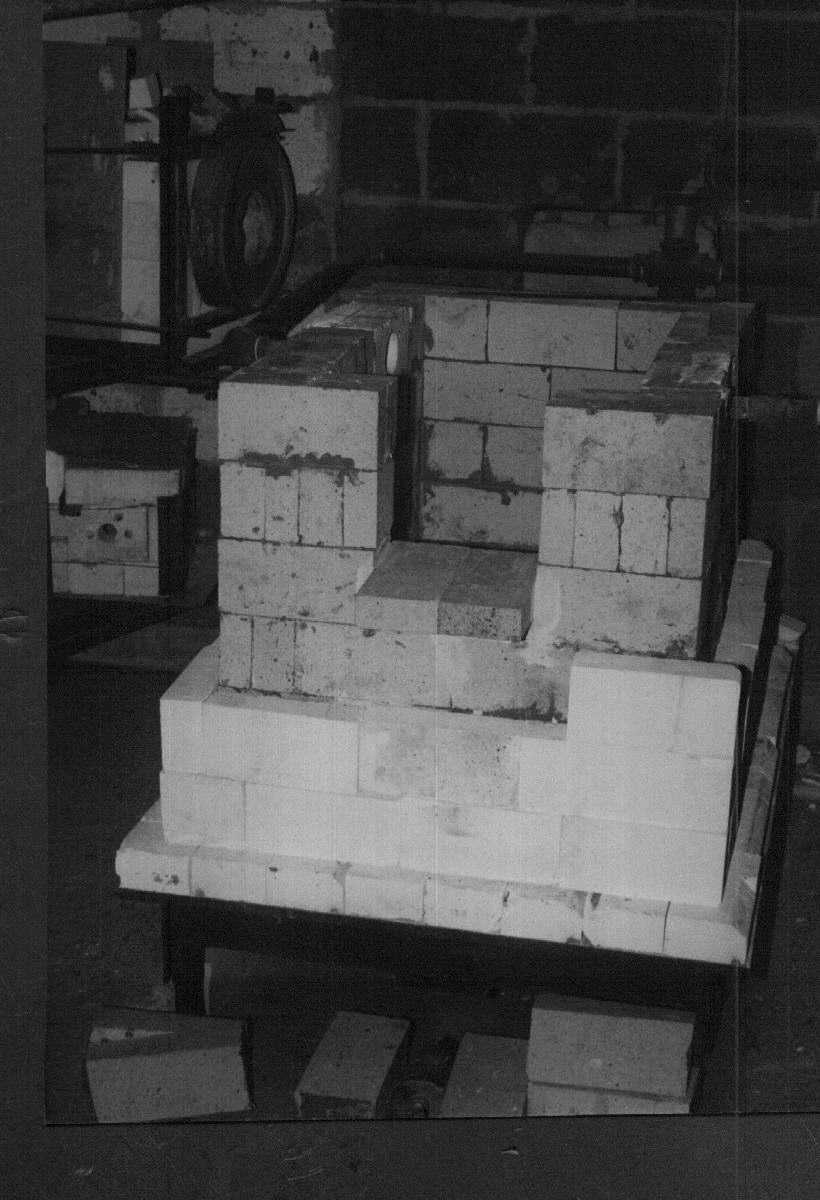
Glass is an oxymoron it is
hard
yet bends, strong but brittle. It can be clear or opaque. It
can expand and shrink greatly with a change in
temperature
or maintain very little
change in size. Some glasses are heavy and some are
significantly
lighter.
Glass has a chemical structure that
resembles a box of springs tangled together. This is
similar to many plastics, and accordingly, glass has
some plastic properties. When glass is
drawn out very thin, its brittleness is reduced and the
resulting fiberglass can be bent.
Glass resists most acids and
alkalis, with the exception of hydrofluoric acid which is
what glass producers used to frost glass before the
EPA.
However, there are special
formulations of glass that will even dissolve in water,
but these are the exception and not
the norm.
To produce glass, sand, lime,
and soda or pot ash are powdered mixed and fired. This
may seem easy however in industry today many additives
are used to gain the
characteristics desired for production. For instance,
if the glass is not to expand much
when heated an amount of borax may be added, or if the
bubbles from melting the batch
need to be removed sooner an amount of arsenic may be
added. Colors require special
formulations of the batch itself. As an example,
manganese
turns glass amethyst, but the
shade of color from blue to red can be changed by
substituting
pot ash for soda ash.
The firing of sand, lime, and
soda ash requires more heat than the melting of glass. In
fact cullet (chunks of glass ) is added to batch (sand,
lime and soda) to help bring down
the necessary reaction temperatures. There are several
reasons for this. First batch is a
powder with many small air pockets entrained in the
pile.
These pockets act as insulation.
Second , when firing batch, the sand does not usually
melt, this would take extreme
temperatures over 3000 degrees F. Instead the sand is
dissolved into the molten lime and
soda much like the amalgamation of silver into mercury
at room temperatures
The heat necessary to fire batch is not easily
obtained.
A simple. fire of wood or coal will
not melt batch. Instead, like a blacksmith’s forge, air
must be forced into the fuel. Most
furnaces are fueled with natural gas and an induced
airflow,
which is usually mixed in a
venturi and introduced into the firebox through
an expanding hole, like a cone so that the
gasses in the pipe are moving fast and the gasses at
the larger opening are moving slower
and ignite. This allows the fuel to burn in the firebox
but as the flame propagates back into
the pipe the velocity and temperature of the faster
moving
cold gasses prevent the flame
from entering the pipe. Another method involves heating
the air before introducing it to the
fuel. But since the air has enough temperature to
ignite
the gas, they must be mixed at the
point that they enter the furnace.
Another problem is once we
achieve
a 2500 degree F. flame, what do we keep it in.
most metals melt at these temperatures. Steel doesn't
melt until 2800 degrees, but at 2500
it will oxidize and turn to rust. Fireboxes used to
contain
these temperatures are built of a
special brick, or refractory, generally composed of
alumina,
with an outer layer of light
spongy insulating brick. this outer layer does not
resist
the corrosive action of glass but is
very good at preventing the transfer of heat. The inner
layer of refractory is glass resistant
but does not stop heat transfer as well, and can be
made
of either tightly stacked blocks
mortared in place or a castable refractory which is
tamped
into place and has no seams.
The outer structure is then
built around the block box. Usually an angle iron frame with
springs is used at the corners which compresses the
outside
layer of blocks to hold them
snugly. This allows for expansion and contraction when
the temperature inside is changed.
All of this is set on a flat steel table to make the
box opening a workable height.
A door to cover the opening is usually made of hard
refractory
and doesn't completely seal
the opening to allow escape of the burnt gasses unless
a chimney or exhaust port is
included in the design. The door can be located on the
side or top however the top located
door will release more hot blast than the side door.
With the gas prices increasing every
year many
people are trying to recycle the heat from the exhaust back into the
combustion
air. Large corporations use regenerators that heat refractory with the
exhaust
and then reverse the air flow and use the hot refractory to heat the
incoming
combustion air. I have come up with a design where I have a stainless
heat
exchanger mounted in the exhaust flow and I pump combustion air through
to the
burner where I introduce the fuel. The combustion air is now 400
degrees at the
inlet of the burner and my gas bill is between $200 and $300 less per
month. The
system cost me about $400 to build and has lasted 13 months of
operation (as of
2/05).
Filling the tank can be done
with a batch or recycled glass cullet. There are many glass
companies that sell their cullet, but this is usually
the leftovers from their work and
contains debris and impurities from their tools, which
necessitates inspection of the cullet
and removal of unwanted impurities before charging the
furnace. Batch is more time
consuming. It needs to be measured, mixed, and requires
a hotter fire, but yields a finer
glass and can be made for more exact purposes.
Colorants can be added to
either
batch or cullet, and can be bought from chemical
suppliers or colorant manufacturers. I recommend buying
from a colorant manufacturer
because of the simplicity of use and the technical
assistance
available to help get the
desired result. Chemicals on the other hand do not come
with instructions. Care must be
observed when using these chemicals and respiratory
protection
is advised. Generally
speaking, cobalt oxide makes blue, selenium makes a
pink
or amberina, copper oxide
makes green and blue, cerium with titanium can make
yellow,
and nickel makes a
blue-violet in potash glass.
Many chemicals have different
effects on different formulations of glass, and some
of these chemicals are extremely potent. A glass blower
I knew tried to make blue from
cobalt oxide, but didn't know how much to put in his
100 pound tank. He thought that he
could put in a hand full and then see what shade of
blue
he had and add more if needed.
After the first handful and some mixing, he found the
glass was black. He did not know
that cobalt oxide is used at a proportion of 5000 to
1 for commercial purposes. His
100 lbs. tank (1600 Oz.) needed less than one ounce to
get the desired result, but in his
hand he could have had 2 or 3 ounces.
Chemical colorants cannot be
fully described without a good understanding of glass
formulation. For instance treating glass with gold is
known to turn it red, however this is
more true of lead glass ( where lead oxide is
substituted
for some of the
sand) and tends to make flint glass brown. Also, there
is a long list of chemicals and
minerals used as additives that also affect the glass.
These include alumina, feldspar,
nepheline syenite, kyanite, kaolin, cryolite, antimony,
arsenous oxide, barium carbonate its
oxide and sulfate, borax, litharge, red lead,
fluorspar.,
bone ash, iron oxide, caustic potash,
saltpeter, potassium carbonate, salt cake, zinc oxide,
and many more.
When batch is fired the metals
tend to become oxides and give off their other radicals
( carbonate, sulfate & sulfide, Etc.). These free
radicals then form gasses and as bubbles
help mix and refine the batch as they rise through the
melt (see refiningbubbles). The
remaining metal oxides
then yield their own properties to the mix. These
properties,
like the list of ingredients, are
numerous and the effect of each is not linear because
some enhance the effect of others,
and some limit the effects of others. Like the basic
sand lime, and soda mix where sand
makes the batch fluidize at higher temperature, lime
also increases viscosity but only
below red heat, as it approaches white heat lime
decreases
viscosity, soda tends to
decrease viscosity and increase solubility, borax tends
to decrease thermal expansion and
contraction. The list is very long.